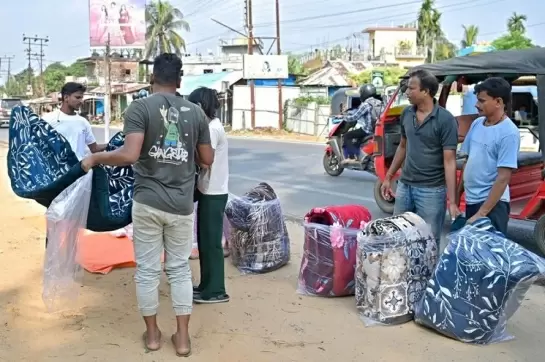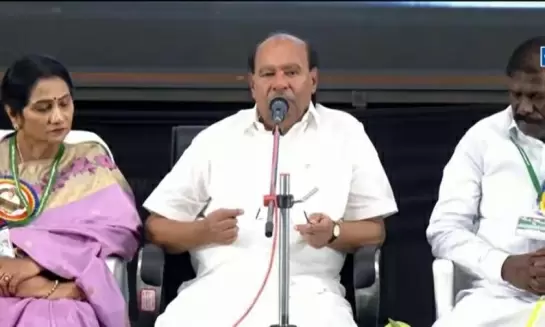Well-prepared to tackle monsoon deficit: Government
03-June-2015
A day after a 12 percent deficit in monsoon rains this season was officially predicted, the government on Wednesday said it was well-prepared to tackle the situation with contingency plans for 580 districts.
"If there are poor rains, in agriculture sector, there would obviously be some losses," Agriculture Minister Radha Mohan Singh said at a press conference here.
"But we have the confidence -- policies in place -- to ensure there is minimum damage to the agriculture sector and economy," added Singh whose ministry normally overseas the overall, nation-wide contingency plan during deficit monsoons.
The minister said even at a similar time last year, the country faced poor rains but the situation was not allowed to go out of hand. "There were losses but the losses were not that huge. This time also we will face the situation."
Science and Technology Minister Harsh Vardhan had said Tuesday that rains during this monsoon was likely to be below normal-to-deficient at 88 percent -- plus or minus four percent -- of the average rainfall.
He also said the probability of below-average monsoon -- of rains between 96 and 104 percent of the long-term average (the average annual rainfall for the period 1951-2000) -- had risen from 68 percent in April to 93 percent now.
Harsh Vardhan has also warned that the northwest region, which includes Delhi, Haryana, western Uttar Pradesh and Rajasthan, would receive just 85 percent of the average rain.
As per the agriculture ministry's latest advance estimate for 2014-15 season, grain production in the country is estimated at 251.12 million tonnes -- 13.92 million tonnes lower than the previous year's record production of 265.04 million tonnes.
"Un-seasonal rains and hailstorm during Feb-March 2015 had significant impact on rabi (winter) crops. As a result of setback in kharif (summer) as well as rabi seasons, the production of most of the crops have declined," it said.
The Kharif season starts in June with sowing when the monsoon begins and the crop is harvested in November, while the rabi season begins with sowing in November and the crop, especially wheat, is harvested in April-May.
At the same time, there was also some hope as the total sown area as per latest reports from states stood at 56.22 lakh hectares compared to 49.04 lakh hectares at this time last year.
"The Sown area coverage of crops is higher in comparison to the previous kharif season," the ministry said.
But experts have said that India needs to better plan the fall-out of low rains.
This is because the annual monsoon accounts for 75 percent of India's rains and over half of the farm sector's water needs. It is also responsible for refilling reservoirs, so crucial for the daily dose of water.
"Monsoon failure clearly remains the biggest risk this year, and some volatility in food prices could be possible despite government intervention," said rating agency Crisil, also cutting its growth projection by 50 basis points.
It also warned that even as rice and wheat stocks can help to curb inflation, there was concern over other commodities such as pulses, oilseeds, fruits and vegetables where either buffer stocks are or storage is not possible.
The predictions on monsoon have spooked the markets as well. The key sensitive index (Sensex) of the Bombay Stock Exchange fell 660.61 points or 2.37 percent on Tuesday, followed by another 351.18 points or 1.29 percent the day after.
Meanwhile, states have also taken their own initiatives, even as Prime Minister Narendra Modi, officials said, was monitoring the situation closely, while also directing concerned ministries to make necessary preparations.
In Maharashtra, the government has published tenders inviting bids for cloud-seeding operations in the state. The issue was also discussed at Tuesday's cabinet meeting presided over by Chief Minister Devendra Fadnavis.
"We plant to undertake cloud seeding in Vidarbha, Marathwada and north Maharashtra on a pilot basis," Revenue Minister Eknath Khadse told reporters in Mumbai, adding Rs.10 crore has been set aside.
Meanwhile, private weather forecaster Skymet ruled out the possibility of northwestern states getting above average rainfall, it said that central parts of the country like western Madhya Pradesh and Maharashtra may get normal rain.
“There is also a possibility that monsoon might pick up at a later stage, when it starts to recede. Monsoon never remains constant and is always varying. It can come late and still be good,” G.P. Sharma, vice-president of meteorology at Skymet told IANS. - IANS
Bangladesh Army Watches As Yunus Administration Grapples With Violence, Chaos
Sri Lankan Navy Arrests 12 TN Fishermen, Impounds Trawler Near Dhanushkodi
Protests Outside Bangladesh High Commission in Delhi Over Lynching of Hindu Youth
Ragging Row Erupts at RG Kar Medical College; First-Year Students File Complaint
Intel Flags ISI Plot To Incite Anti-India Fury In Bangladesh, Push New Delhi Into Military Response









